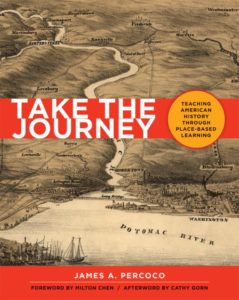Teaching History with Place-Based Learning
Take the Journey: Teaching American History through Place-Based Learning
By James A. Percoco
(Stenhouse, 2017 – Learn more)
 Reviewed by Linda Biondi
Reviewed by Linda Biondi
“I never teach my pupils. I only attempt to provide the conditions in which they can learn.” – Albert Einstein
James Percoco, a 33-year classroom veteran and member of the National Teacher Hall of Fame, is the type of social studies teacher I wish I had had in school. His book Take the Journey: Teaching American History Through Place-Based Learning is the one of the best resources I’ve come across for teaching United States history.
 Percoco, a teacher, historian, and author, invites you to have your students become actively engaged in their learning of American history. He invites you to “walk in the footsteps of the people who made history happen.”
Percoco, a teacher, historian, and author, invites you to have your students become actively engaged in their learning of American history. He invites you to “walk in the footsteps of the people who made history happen.”
His work is nothing short of astounding and is a testimony to educators who are working with the Journey through Hallowed Ground Partnership, a non-profit, four-state enterprise “dedicated to raising awareness of the unparalleled American heritage in the region running from Gettysburg, PA., through Maryland and Harpers Ferry, W.VA., to Thomas Jefferson’s Monticello in Charlottesville, VA.”
This 180-mile National Heritage Area is teeming with history. I have to admit that I didn’t know about the Hallowed Ground National Heritage Area. Pulitzer Prize winning author Geraldine Brooks aptly describes the space (p. 2):
This remarkable region tells the story of how and where America happened. It has the power to transport us on the greatest journey of all; the journey of empathy and imagination into the lives of the people – famous and unknown, humble and distinguished – who shaped the country and made us who we are.”
After reading this book, I felt even more passionate about bringing historic sites into the social studies classroom, whether through field trips or virtual visits. Although many of the lessons Percoco shares are “place-bound” in the Journey through Hallowed Ground National Heritage Area along the East Coast, his overarching premise is that every community’s history is crucial to the development of the United States.
The lessons embedded in the text are easily adaptable, and the book reads like a travelogue. You learn from Percoco’s errors, successes, honesty, insight, and most of all, his enthusiasm and knowledge about teaching and history.
My first thoughts when I began to read this book were
✻ How many grants do you need to write to “get there” on this journey? None. You can do this with your local history.
✻ How can you cover the Standards? The lessons are Common Core based and rely predominately on primary sources.
✻ How can a teacher manage teaching, traveling, and coordinating everything? No problem. All the activities can be done without leaving the classroom (although I would dearly love to take students there!).
✻ Where can a teacher find the information to implement this in his/her classroom without spending day and night working on it? It’s out there – primary sources are there via the Internet, whether you need the Declaration of Independence, a daily account of the Civil War, or speeches.
Linking past and present
I had chills as I read this book because Percoco writes from the heart. His purpose and passion were evident throughout as he examined, probed, and reflected on the making of our country. His book is not a sugarcoated journey of the United States but a journey that shows what makes our country great, despite its faults, and how to impart that wisdom and cultural understanding to our students.
For example, he demonstrates to the teacher how to connect historic content to the present by comparing what the students learn about Thomas Jefferson and the founding documents to how the Black Lives Matter movement is connected to Jefferson’s ideas and principles.
This inquiry-based approach challenges students and teachers to think beyond the textbook. As I turned each page, I learned more about American history and how all of the puzzle pieces fit together to make a towering portrait of the United States of America.
Fashioning lessons from sources
Imagine being transported in time. Percoco writes about his own research journey in such a way that you can visualize the documents he is discovering. You can see the yellowed pages, smell the musty boxes of artifacts, experience the joy and excitement as he uncovers new information, and feel the exhilaration as he thinks of ways to present what he has learned to his students.
All the lesson plans in the book are teacher tested (by Percoco’s own students and in the classrooms of partnership schools) and adaptable for use in place-based history education in any community across the United States. They provide the objective, essential question, documents, exit slips – whatever you need – and are engaging, hands on, and something that your students will always remember.
I am sure many educators have heard, “Why do I have to learn this? It’s history. It happened a long time ago. What does it have to do with me?” With the guidance Percoco offers, students can become engaged and then invested as they learn how to brainstorm, analyze, organize, synthesize and respond to text, prompts and questions.
What I also appreciate is the book’s hands-on, minds-on aspect that encourages students to share what they have learned through real world skills such as photography, movie making, writing, editing, and set design. Students practice inquiry, interviewing, public speaking, and research, all critical twenty-first century skills. In fact, through Percoco’s guidance, service learning projects such as engaging in local historic preservation have evolved.
Attuned to instructional shifts
Wonder how it will link in with the current instructional shifts for social studies? The book is the most relevant and up-to-date teaching text I have read. You will continue to learn how to use “questions to spark curiosity, guide instruction, deepen investigations, acquire rigorous content, and apply knowledge and ideas in real world settings to become active and engaged citizens in the 21st century.”(College, Career, and Civic Life (C3) Framework for Social Studies State Standards).
Take the journey. I guarantee that you will be thrilled that you did. Follow Percoco’s lead, immerse yourself in the techniques of place-based learning, and students will be “breaking down the door” to get into your classroom and ultimately share their knowledge and expertise with others – becoming better US and world citizens.
Be prepared for them to want to take charge of their learning. Be prepared for other teachers to ask you what are you doing to get them so excited about learning. Be prepared for YOU to be breaking down the door to your classroom, anxious to begin the day with your students.
Linda Biondi recently retired from her position as fourth grade teacher at Sharon Elementary School in Robbinsville, NJ. She has been the recipient of several educational grants, a Teacher Consultant with the National Writing Project, and a participant on the NJ Department of Education Teacher Advisory Panel and with ECET2 Celebrate Teaching. She hopes to continue her work in schools as a teacher mentor and trainer.


































Linda, this sounds like a wonderful book. I will definitely get a copy.